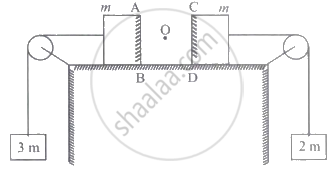Advertisements
Advertisements
Question
Complete a sentence and explain it.
During a collision, ______ remains constant.
Solution
During collision momentum of the system remains constant.
Explanation:
According to the law of conservation of momentum, momentum is redistributed between colliding objects. When the momentum of one object decreases, the momentum of the other object increases. As a result, momentum remains constant even when objects collide.
APPEARS IN
RELATED QUESTIONS
A truck starts from rest and rolls down a hill with a constant acceleration. It travels a distance of 400 m in 20 s. Find its acceleration. Find the force acting on it if its mass is 7 metric tonnes (Hint: 1 metric tonne = 1000 kg).
A 8000 kg engine pulls a train of 5 wagons, each of 2000 kg. along a horizontal track. If the engine exerts a force of 40000 N and the track offers a friction force of 5000 N, then calculate:
- the net accelerating force and
- the acceleration of the train.
An automobile vehicle has a mass of 1500 kg. What must be the force between the vehicle and road if the vehicle is to be stopped with a negative acceleration of 1.7 m s−2?
A bullet of mass 10 g travelling horizontally with a velocity of 150 m s−1 strikes a stationary wooden block and comes to rest in 0.03 s. Calculate the distance of penetration of the bullet into the block. Also calculate the magnitude of the force exerted by the wooden block on the bullet.
An object of mass 100 kg is accelerated uniformly from a velocity of 5 ms−1 to 8 ms−1 in 6 s. Calculate the initial and final momentum of the object. Also, find the magnitude of the force exerted on the object.
The following is the distance-time table of an object in motion:
| Time in seconds | Distance in metres |
| 0 | 0 |
| 1 | 1 |
| 2 | 8 |
| 3 | 27 |
| 4 | 64 |
| 5 | 125 |
| 6 | 216 |
| 7 | 343 |
- What conclusion can you draw about the acceleration? Is it constant, increasing, decreasing, or zero?
- What do you infer about the forces acting on the object?
A large truck and a car, both moving with a velocity of magnitude v, have a head-on collision and both of them come to a halt after that. If the collision lasts for 1 s:-
(a) Which vehicle experiences the greater force of impact?
(b) Which vehicle experiences the greater change in momentum?
(c) Which vehicle experiences the greater acceleration?
(d)Why is the car likely to suffer more damage than the truck?
Fill in the following blanks with suitable words :
Newton’s second law of motion can be written as Force = mass × _____________ or Force = _____________ of change of _____________.
How long will it take a force of 10 N to stop a mass of 2.5 kg which is moving at 20 m/s ?
State and explain Newton’s second law of motion.
A passenger in a moving train tosses a coin which falls behind him. This shows that the motion of train is :
The acceleration produced by a force of 5 N acting on a mass of 20 kg in m/s2 is :
Which of the following situations involves the Newton's second law of motion?
Newton’s III law is applicable
Deduce the equation of a force using Newton’s second law of motion.
Using the second law of motion, derive the relation between force and acceleration. A bullet of 10 g strikes a sand-bag at a speed of 103 m s-1 and gets embedded after travelling 5 cm. Calculate
(i) the resistive force exerted by the sand on the bullet
(ii) the time is taken by the bullet to come to rest.
A force vector applied on a mass is represented as `vecF = 6hati - 8hatj + 10hatk` N and accelerates the mass at 1 ms-2. The mass of the body is ______.
Two blocks each of mass m lie on a smooth table. They are attached to two other masses as shown in the figure. The pulleys and strings are light. An object O is kept at rest on the table. The sides AB and CD of the two blocks are plane and made reflecting. The acceleration of two images formed in those two reflecting surfaces with respect to each other is ______.

